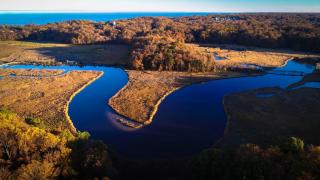Oyster Facts

What are spat? Spat is a life stage of the oyster during which they transition from mobile larva to “fixed” organisms attached to hard surfaces where they continue to grow into mature oysters.
Where are the spat grown? The spat are grown in cages for 9-10 months from your pier, or below the Railroad Trail boardwalk in Fishing Creek if you do not have a pier.
Where are yearling oysters released? The yearling oysters will be released in designated oyster sanctuaries under the guidance of the Maryland Department of Natural Resources (DNR). A suitable planting site has already been identified in the Bay just offshore from Chesapeake Beach; the location is known as Old Rock. CBOCS is also exploring Fishing Creek planting options. However, oysters must be planted on a hard substrate or their likelihood of survival is very small. So given Fishing Creek’s muddy bottom, it is unclear at this time if a suitable solution will be found to allow oysters to be planted there.
Do I need to purchase a BOCS, or have a pier to participate? No. There are a variety of ways to participate in CBOCS without purchasing a BOCS or having a pier. Primarily we need people willing to donate their time and energy to help maintain the program. For example, we need your help receiving and deploying spat in the fall, planting yearling oysters in the spring, weatherizing BOCSes annually, or there are a variety of committees to help out with as well.
Are there any schools involved in CBOCS? Yes. Beach Elementary School is an active partner in CBOCS and is currently incorporating aspects of oyster restoration into their environmental curriculum for fifth graders.
Did you know……
- One oyster can filter 50 gallons of water in one day. That’s a lot of pollutants removed from the bay!
- Two hundred years ago there were enough oysters to filter the whole bay in one day.
- The current level of oysters take two years to filter the whole bay.
- Baby oysters, called spat, attach to other oyster shells and rocks – and they stay in the same spot for the rest of their lives.
- Oysters live the Brackish Life. They love a little salty – a little fresh.
- Oysters are bivalve mollusks – they have two shells and are in the same family as scallops, mussels, clams and cockles
- There are 200 species of oysters. All oysters create pearls but only the Pearl Oyster makes the prettiest pearls used in jewelry.
- Most oysters on the East Coast and in the Chesapeake Bay are the same species – Crassotrea Virginica
- Humans have been eating and cultivating oysters as far back as the Roman Empire.
- Oysters are nutritious containing zinc, calcium, magnesium, protein, selenium, Vitamins A and B12 and iron.
- Oyster Reefs provide habitat for fish, crabs and worms protecting them from large predators
- Large oyster reefs can protect shorelines from erosion
- Oyster taste comes from their environment. Water salinity, currents and available nutrients can change taste from savory and briney (East Coast) to sweet and buttery (West Coast)
- The recipe for Oysters Rockefeller was invented in 1899 at Antoine’s restaurant in New Orleans. Upon tasting the delicacy consisting of oysters, butter, parsley and bread crumbs, a customer exclaimed “Why this is as rich as Rockefeller”.


